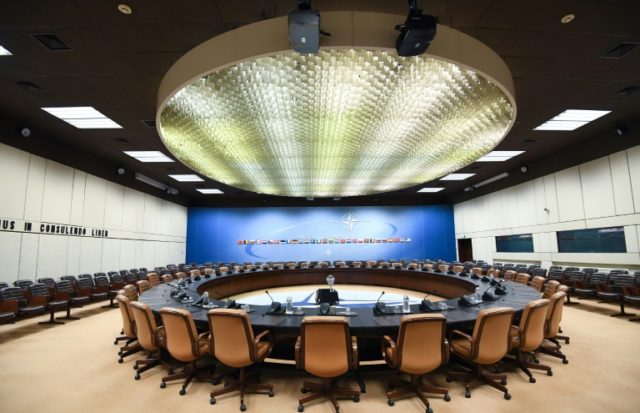Brussels (AFP) – It was the venue for some of the most important and dramatic moments in NATO’s history but on Friday the alliance bid farewell to its historic “Room 1” conference chamber.
For 50 years NATO leaders, ministers and ambassadors have held their most important debates and taken their biggest decisions in the brown leather chairs of Room 1, buried in the alliance’s crumbling old base on the outskirts of Brussels.
Now NATO is moving to a brand new high-tech glass and steel headquarters, leaving behind a building steeped in Cold War history.
Friday’s meeting of foreign ministers was the last to be held in Room 1 and NATO chief Jens Stoltenberg closed proceedings by symbolically banging an ornate wooden gavel donated by Iceland in the 1960s.
“In Allied navies there is often a tradition of formally decommissioning warships. Today, we decommission this chamber,” Stoltenberg said.
“If they could speak, these walls would have many tales to tell.”
Room 1 was where NATO’s Article 5 self-defence pact was invoked for the first and only time in the wake of the 9/11 attacks on the United States.
It was also where allies decided to launch military interventions in the Balkans, Libya and Afghanistan.
In 1990, after the fall of the Berlin Wall, as the West fretted about what role a reunified Germany might play in Europe, then German chancellor Helmut Kohl jumped in his official car and raced to NATO headquarters.
He spent three hours answering questions from ambassadors in Room 1, reassuring them that reunification would mean “a European Germany, not a German Europe”.
The new HQ’s palatial conference room is equipped with the latest technology but it is unlikely to see a scene to match the poignancy and dedication of then-secretary general Manfred Woerner’s appearance in 1994.
Dying of cancer, Woerner chaired a meeting hooked up to a drip with doctors standing by him as he encouraged allies to back intervention in support of UN forces in Yugoslavia.
But perhaps the old headquarters’ most dramatic moment came not in Room 1 but in the larger Room 16 in 1991 as the old world order crumbled dizzyingly.
“The Soviet ambassador asked if we could interrupt a meeting of the North Atlantic cooperation council so that he could go and take a call from Boris Yeltsin in the Kremlin,” a veteran NATO official recalled.
“He came back about half an hour later and asked if the Soviet flag could be replaced by the Russian flag because he had just been informed that the Soviet Union had been dissolved.”

COMMENTS
Please let us know if you're having issues with commenting.